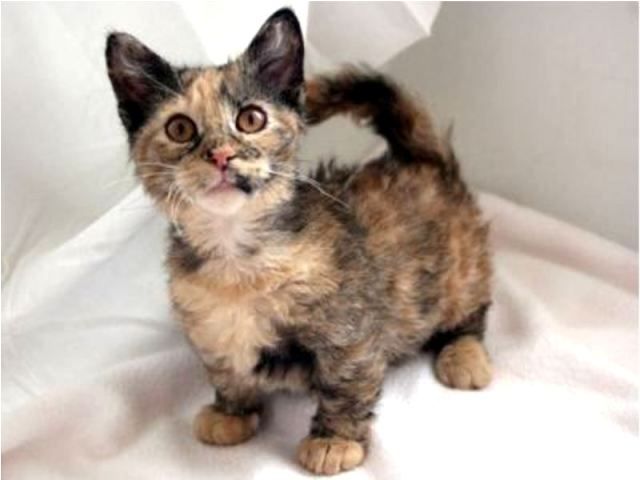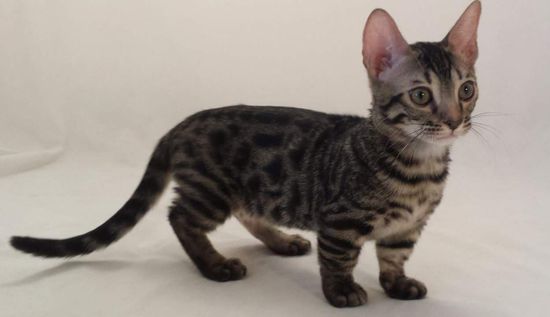Yes, the Maine Coon is a wonderful giant of a cat but not everyone wants such a huge pet.
For some pet owners, a tiny and miniature kitty is what tickles their fancy – and this has led to the development of small cat breeds.
There are three kinds of small cats: miniature, teacup, and dwarfs.
Although these terms are often used interchangeably, there are some subtle differences between them.
However, all have one thing in common – they are tiny cats when fully grown.
In this post, we will have a detailed look into dwarf cats.
What Are Dwarf Cats?
Dwarf cats are simply cats that are smaller than average. There is no set size for a dwarf cat, but they are typically about half the size of a regular cat.
This makes them very portable and easy to take care of. They also have all the same features as a regular cat, just in a miniature form.
Dwarf cats are small because of a genetic mutation called dwarfism. This mutation can occur in any animal, not just cats, and it is caused by a change in genes.
This change can be passed down from the parents to the offspring, which is why you will often see whole litters of dwarf kittens.
While there are many different types of dwarfism, the most common type in cats is called achondroplastic dwarfism.
This type is characterized by short limbs and a large head in proportion to the body. It is caused by a mutation in the gene that controls bone growth.
Dwarf cats started to be developed recently (the 1980s) and they are yet to be officially recognized in some cat registries.
In fact, some vets discourage breeders from developing dwarf cats and these cats have even been banned in Europe.
Dwarf Cat Breeds
I. Munchkin

The Munchkin is arguably the most popular dwarf cat mostly because it was the first dwarf cat breed to be recognized by the International Cat Association.
This breed was stumbled upon accidentally when a music teacher adopted a stray cat who happened to be pregnant.
The cat would later give birth to a litter of short-legged kittens and these became the parents of the munchkin breed.
Related Post: Owning a Munchkin Ragdoll Cat: Everything You Need To Know
II. Bambino

Bambinos are a cross between a Munchkin cat and a Sphynx cat.
They have the short legs of a Munchkin, but they also have the hairless body of a Sphynx.
III. Dwelf

Dwelfs are a cross between a Munchkin cat and an American Curl.
They have the short legs of a Munchkin, but they also have the curled ears of an American Curl.
IV. Minskin

Minskis are a cross between a Munchkin cat and a Devon Rex.
They have the short legs of a Munchkin, but they also have the short hair and wrinkles of a Devon Rex.
V. Napoleon

Napoleons are a cross between a Munchkin cat and a Persian cat.
They have the short legs of a Munchkin, but they also have the long hair and flat face of a Persian.
VI. Skookum

Skookums are a cross between a Munchkin cat and a Scottish Fold.
They have the short legs of a Munchkin, but they also have the folded ears of a Scottish Fold.
VII. Kinkalow

Kinkalows are a cross between a Munchkin cat and an American curl.
They have the short legs of a Munchkin, but they also have the curled ears of an American curl.
VIII. Lambkin

Lambkins are a cross between a Munchkin cat and a Selkirk Rex.
They have the short legs of a Munchkin, but they also have the curly hair of a Selkirk Rex.
IX. Genetta

Genettas are a cross between a Munchkin cat and a Bengal cat.
They have the short legs of a Munchkin, but they also have the spots and stripes of a Bengal.
Dwarf Cats’ Health Issues
Because dwarf cats are so small, they are more prone to health problems than larger breeds.
They can have heart defects, respiratory problems, and skeletal abnormalities.
The following are some of the common ailments that are common in dwarf cat breeds:
A. Hormone imbalances
Dwarf cats are prone to hormone imbalances, which can cause a variety of health problems.
For example, dwarf cats with too much growth hormone can suffer from gigantism, while those with too little can have dwarfism.
Either condition can lead to a shortened lifespan and a host of other health problems.
B. Kidney disease
Dwarf cats are also more prone to kidney disease than other breeds. This is because their kidneys are smaller and not as efficient at filtering out toxins.
Kidney disease can cause a host of problems, including weight loss, lethargy, and vomiting.
C. Degenerative joint disease (DJD)
DJD is also known as feline arthritis. It is a condition that causes the cartilage in your cat’s joints to break down, resulting in pain and stiffness.
DJD can be very debilitating and make it difficult for your cat to move around.
D. Spinal problems like herniated discs and spondylosis
Dwarf cats are also more prone to spinal problems than other breeds. This is because their bodies are so small and their bones are not as strong.
Spinal problems can cause a great deal of pain and may even lead to paralysis.
E. Mobility problems
Dwarf cats often have mobility problems because of their small size and fragile bones.
They may have difficulty jumping and climbing, and they may need help getting in and out of their litter box.
F. Lordosis
Lordosis is a condition that causes the spine to curve inward. This can make it difficult for your cat to move around and may even lead to paralysis.
Lordosis is prevalent in dwarf cat breeds because of their weak skeletal structure.
G. Pectus excavatum
Pectus excavatum is a condition in which the breastbone is sunken. This can make it difficult for your cat to breathe and may also lead to heart problems.
Pectus excavatum is common in dwarf cat breeds because of their small size.
How Rare Are Dwarf Cats?
Dwarfism is a rare genetic disorder and as such, dwarf cats are quite rare.
Very few breeders venture into breeding this cat for several reasons. For starters, dwarf cats are susceptible to a plethora of health issues and so not very many pet owners are interested in them.
Secondly, the cat community has mixed feelings about dwarf cats and some believe dwarf cats shouldn’t be developed.
In fact, dwarf cats are seldom accepted outside the United States and have even been banned by the European Convention for the Protection of Pet Animals.
Because of their rarity, these breeds are usually pricey and hard to find.
Life Span of Dwarf Cats
Dwarf cats usually have a lifespan of 10-15 years. However, because they are more prone to health problems, some dwarf cats may not live as long as others.
There are a couple of steps you can take to help your dwarf cat live longer.
First, make sure you get them from a reputable breeder who can provide health clearances for their parents.
Secondly, take them to the vet regularly for checkups and vaccinations.
Additionally, feed them a high-quality diet and provide them with plenty of exercises.
By taking these steps, you can help your dwarf cat live a long and healthy life.
How Much Do Dwarf Cats Cost?
The price of a dwarf cat depends on the breed, as well as the breeder.
However, you can expect to pay anywhere from $600 to $1,200 for a dwarf kitten.
Dwarf cats are available from many different breeders, but the best place to find one is through a specialized Dwarf Cat Breeder.
These breeders have years of experience and can help you find the perfect dwarf cat for your home.
Parting Thoughts
Dwarf cats are unique and fascinating creatures. However, they are also quite rare and often come with a host of health problems.
If you’re considering adding one of these cats to your family, be sure to do your research and find a reputable breeder.
Additionally, be prepared to spend a bit more on their care, as they will likely need regular vet visits and a high-quality diet.
If you are ready and willing to put in the work, a dwarf cat will enjoy a long, happy and healthy life.

Hi! I am Eleanor Price. I started this website after my cat, Louie, almost died from a case of botulism (a type of food poisoning often caused by bacteria that grow on food items). Turned out that my cat’s diet was the problem. I have made it my duty to provide the best information and recommendations about everything cat lovers need to know about their felines’ health and wellbeing. My goal is to find the most informative content on anything feline-related and share it with fellow hardworking kitty lovers.

